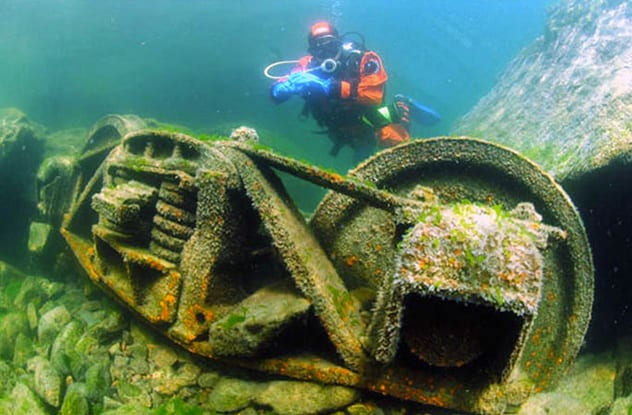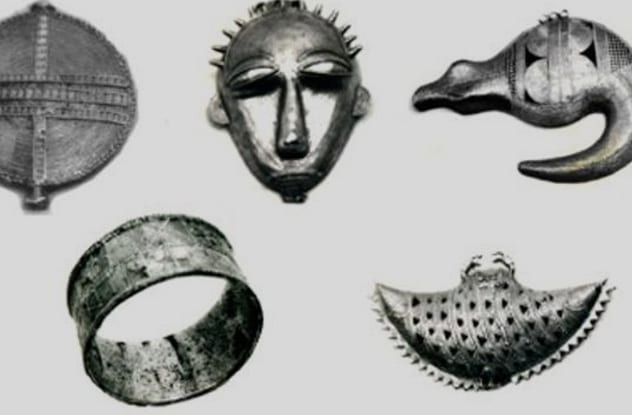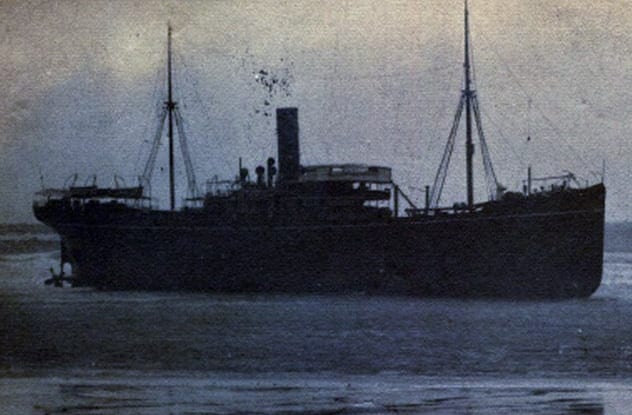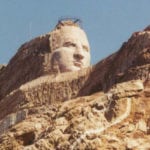 History
History  History
History  Creepy
Creepy 10 More Representations of Death from Myth, Legend, and Folktale
 Technology
Technology 10 Scientific Breakthroughs of 2025 That’ll Change Everything
 Our World
Our World 10 Ways Icelandic Culture Makes Other Countries Look Boring
 Misconceptions
Misconceptions 10 Common Misconceptions About the Victorian Era
 Mysteries
Mysteries 10 Strange Unexplained Mysteries of 2025
 Miscellaneous
Miscellaneous 10 of History’s Most Bell-Ringing Finishing Moves
 History
History 10 Great Escapes That Ended Right Back in Captivity
 Weird Stuff
Weird Stuff 10 Fascinating Things You Might Not Know About Spiders
 Food
Food 10 Everyday Foods You Didn’t Know Were Invented by the U.S. Military
 History
History 10 Most Influential Protests in Modern History
 Creepy
Creepy 10 More Representations of Death from Myth, Legend, and Folktale
 Technology
Technology 10 Scientific Breakthroughs of 2025 That’ll Change Everything
Who's Behind Listverse?

Jamie Frater
Head Editor
Jamie founded Listverse due to an insatiable desire to share fascinating, obscure, and bizarre facts. He has been a guest speaker on numerous national radio and television stations and is a five time published author.
More About Us Our World
Our World 10 Ways Icelandic Culture Makes Other Countries Look Boring
 Misconceptions
Misconceptions 10 Common Misconceptions About the Victorian Era
 Mysteries
Mysteries 10 Strange Unexplained Mysteries of 2025
 Miscellaneous
Miscellaneous 10 of History’s Most Bell-Ringing Finishing Moves
 History
History 10 Great Escapes That Ended Right Back in Captivity
 Weird Stuff
Weird Stuff 10 Fascinating Things You Might Not Know About Spiders
 Food
Food 10 Everyday Foods You Didn’t Know Were Invented by the U.S. Military
10 More Missing Treasures You Can Still Find
Find treasure, and you could become instantly rich, maybe even famous. You could discover a part of history that we thought was gone forever, or something we never even knew existed. And unlike many other legends, hidden treasure is well documented. Any one of us could stumble across some at any point in our lives, without warning.
10Elysian Park

Elysian Park is LA’s oldest and second-largest park, spread over roughly 600 acres. It’s not beyond the realms of possibility, therefore, that the legends of treasure there lost for over 150 years could be true.
During the US-Mexico war of 1846–1848, Southern California was a hotly contested territory. Troops from both sides fought for control of the land, striking fear into the hearts of the local elite. Legend has it that, to protect their immense wealth from hostile forces, locals took to the hills, caves, and ravines of this vast park to hide gold, jewels, and more.
Newspapers as far back as 1896 show that people have been searching for the treasure ever since. If the stories are true, it’s likely that many of the residents later recovered their riches. But it is equally likely that many died, fled, or lost their wealth forever by the time the war ended. The most famous example is that of Don Francisco Avila, who built the first-ever house in LA, which stands to this day. Avila was an extremely wealthy political figure and businessman and is likely to have stashed considerable amounts of expensive goods during the war.[1]
Treasure hunter Roy Roush claimed to have found etchings in rocks that he believes may point to the location of this treasure, while another man by the name of Marvin Baker also claims to have found such makeshift maps in the rocks. To this day, however, no treasure has been discovered in Elysian Park.
9Lake Toplitz

High in the Austrian Alps, and deep in the dense mountain forest, Lake Toplitz is an ideal place to hide $5.6 billion of stolen gold. Rumors have long surrounded this isolated lake, with lifelong local Michl Kaltenbrunner claiming she can “guarantee” that the Nazis dumped gold in the lake. She would have been about 10 years old when World War II ended.[2]
What gives this theory some credence is that £700 million of counterfeit notes that Hitler had planned to use to destabilize the British economy were recovered from the lake in 1959. The dilemma here of course is the question of whether this is what the locals saw the Nazis dump in the lake or just part of what went down. The lake is over 300 feet (100 meters) deep, with a layer of logs floating roughly halfway down, making investigations a very risky ordeal.
8Poverty Island

Poverty Island in Lake Michigan is home to a lonely lighthouse and an absolutely ridiculous amount of gold, if legends are to be believed. Estimates based placed the value of the lost gold at around $400 million today. There are many legends surrounding the possible origin of this gold, the first of which dates back to the 1750s. According to this theory, British forces attacked a French ship sailing across Lake Michigan to woo the Native Americans with gold. To prevent the British from seizing the gold, the captain ordered it be thrown overboard. An almost identical story is attributed to the War of 1812.
Another legend speaks of James Strang, whose gold allegedly ended up in the lake after he was overthrown by his colony on a nearby island. The French make another appearance, with some legends saying the gold belonged to Napoleon Bonaparte the third. Bonaparte supposedly sent the gold to support the Confederates during the civil war, but the plan was thwarted when the ship was attacked and sunk by Canadian pirates. It is unknown whether they apologized.
According to yet another legend, the son of a lighthouse keeper saw a crew of treasure hunters celebrating aboard their ship one night in 1933. The men had reportedly been searching the lake for years, and when it finally looked as though they had found it, a storm hit and sunk them to the depths of Lake Michigan.[3]
The legends are far from over however, as in 2014, two men claimed to have found the shipwreck of what they claim to be the Griffin, a French ship. However, three years on, they have yet to provide any proof of their supposed $2 million discovery.
7Skeleton Canyon

Skeleton Canyon is located in the Peloncillo Mountains along the Arizona-New Mexico border. Prior to the 20th century, the canyon was a popular trail for smugglers looking to quietly move their booty to Tucson, as well as for the bandits looking to ambush them. While it is possible or even likely that Skeleton Canyon contains multiple sites of hidden treasure, the Skeleton Canyon Treasure refers to one specific haul, originally known as the Monterrey loot.
Toward the end of the 19th century, American bandits carried out a raid on the Mexican city of Monterrey. Despite a few deaths, the raid was quite successful, with the bandits purportedly making off with 39 bars of gold, $1 million worth of diamonds, bags or silver and gold coins, and countless golden crucifixes, chalices, statues, and other humble Catholic artifacts.
The band of bandits were hotly pursued on the 1,000-mile trail, leading them to hide as much of the treasure as they could. Many of these men died on the journey, which is how the canyon got its name. There have been several reports throughout the years of men who set up camp, only to quickly disappear, leading locals to believe they may have been recovering the treasure. It has never been proven whether any or all of the treasure has been recovered, so this canyon may have more than a few skeletons in its closet to this day.[4]
6Kruger’s Millions

Stephanus Johannes Paulus Kruger, or “Uncle Paul” for short, was the third president of the South African Republic for over 17 years at the close of the 19th century. With the advent of the Second Boer War, and public opinion turning against him, Kruger fled South Africa in 1900, two years before his presidency officially ended. But not before taking a little something for himself first.
As Kruger made his escape for Europe, rumors swirled that the train he was riding on was also carrying a substantial amount of gold. Subsequent investigations revealed not only that £1.5 million had been stolen from the government, but that it had been slowly siphoned off for months. Five years later, a prisoner named John Holtzhausen revealed that he had been hired to bury the gold north of Leydsdorp and was the last surviving member of the team.[5]
In 2001, a Zulu family in the town of Ermelo came forward claiming to have found some of the lost coins, while last year another man claims to have found the treasure at the base of the Emmarentia dam. Even if both of these claims are true (and neither has been verified), Ermelo councillors believe the stash would have been split up into at least three caches.
5Tsar’s Treasure

When most people think of Russian royalty, they’ll think of one of three things: oppression, conspiracy, or decadence. It should come as no surprise therefore that Tsar Nicholas II allegedly stashed away what would now be billions of dollars’ worth of treasure prior to the Bolshevik Revolution in 1917. The only question is where.
One theory is that the treasure, consisting mainly of gold, was hidden or simply lost in the tunnels underneath Omsk, a Siberian city that acted as a de facto capital during the revolution. Omsk has a vast network of underground tunnels, and it is a known fact that gold was transported there during the revolution, making this a perfectly plausible theory.
In 2001, it was suggested that the gold could be hidden beneath the home of ballerina/royal mistress Mathilda Kshesinskaya. Excavations of her St. Petersburg home appear to have been a fruitless effort, but since Kshesinskaya only died in 1971, it is possible the gold was moved at some point during the intervening years.[6]
A third theory suggests that the gold went down with the RMS Republic, an Irish ship that sank off the coast of Nantucket. According to this theory, the gold was being sent by the French to the Tsar in secret, when the Republic collided with another ship and sank. The wreck was rediscovered in 1981, but a 74-day search conducted several years later turned up nothing.
Finally, another theory suggests that the gold may have been aboard a trans-Siberian train that crashed into Lake Baikal, which just happens to be the oldest and deepest lake in the world. Excavations have been attempted, but have met with little success other than confirming the location of the train.
4Ivory Coast Crown Jewels

In 2010, the Ivory Coast held its first election in over 10 years, which saw the incumbent president Gbagbo pitted against the much more popular Alassane Ouattara. When Gbagbo was declared the winner, the country was thrown into a turmoil that would become known as the 2010–2011 Ivorian Crisis. Although the crisis was short-lived, and Ouattara has shown himself to be a promising figure for change after being democratically reelected five years later, this brief conflict may have cost the coast one of its most valuable treasures: the Ivory Coast Crown Jewels.
As civil war raged through the country, with heavy UN & French intervention, over 80 objects were stolen from the Museum of Civilizations, including masks, necklaces, scepters, and religious artifacts. Valued at around $6 million, it is the immense cultural significance of these objects that sets them apart from other similar losses. Unlike most crown jewels, which are passed down from heir to heir, the Ivory Coast collection represented multiple kingdoms and dynasties, making the loss of this diverse collection especially devastating. Interpol is trying to locate the items on the black market, but have had no success to date.[7]
3Awa Maru

Originally intended to be an ocean liner, the Awa Maru was a Japanese warship built during World War II. With the end of the war drawing near, the US grew increasingly concerned for Allied troops being held captive in Japan. Not because they feared mass execution but because the Japanese were low on resources and would prioritize their own people over their enemies. Switzerland, in its usual peaceful manner, negotiated a deal between the two sides: the US would send emergency supplies, allowing Japanese ships to pass by un-bombed.
Seeing an opportunity to turn the war around, the Japanese used ships much larger than necessary, letting them safely transport raw materials, their brightest citizens, and a collection of invaluable treasure, such as gold and art. Unfortunately for the Japanese, bad weather prevented the entire US fleet from hearing the ‘no-bombing’ plan, and the USS Queenfish torpedoed the Awa Maru in 1945, killing all but one of the 2,004 people onboard.[8]
Although the US concealed the location of the sunken ship for some time, it was declassified and revealed to have gone down in Chinese waters. In the 1970s, a Chinese expedition spent millions trying to recover the treasure, but turned up nothing. The value of the treasure, which included ivory, precious metal, gemstones, and historical artifacts, has been estimated as $5–10 billion, making it potentially the biggest haul in treasure-hunting history.
2Brink’s-Mat Robbery

The Brink’s-Mat warehouse was a highly secure facility located in Heathrow Airport, London. On November 26, 1983, the security guard on shift was Anthony Black, an inside man who allowed six gunmen into the facility.
The original plan was to break in and abscond with as much cash as possible, but upon entering, the men discovered much more than they bargained for. The warehouse was teeming with platinum, gold, diamonds, checks, and cold hard cash. After dousing the staff in petrol and threatening to set them alight, the men packed up the goods and fled. What was intended to be a haul of around £3 million cash ended up being a literal treasure trove to the tune of £26 million.[9]
Black, who has links to the criminal underworld through his brother-in-law, was sentenced to six years in prison, while two of the armed men were caught and also received sentences of 25 years. Police could trace how a lot of the haul was laundered, but it is believed that £10 million worth of gold remains hidden, and the case has yet to be solved in full.
1Hatton Garden Heist

Hatton Garden is the Amsterdam of Britain, with a long history of jewelers and diamond traders taking up residence in the London district. It should come as no surprise so that it is also home to some of the UK’s highest security safes, such as the aptly named Hatton Garden Safe Deposit.
What makes this robbery particularly interesting, apart from being the single biggest robbery in British history, is it took place over two days, during the Easter Bank Holiday weekend in April 2015. On their first attempt, four elderly career thieves used an elevator shaft to gain entry to the lower levels of the Hatton Garden Safe Deposit. Using a diamond-tipped drill, they bore through the walls and gained entry to the safe. They then discovered that they couldn’t enter the cabinets where the goods were kept, so they left, got the necessary supplies, and returned the next day. They then walked out with all measure of gold, diamonds, jewelry, and cash. Original estimates placed the cost of the robbery at £14 million, but that has now risen to £25 million. Only one-third of the loot has ever been recovered.[10]
An alarm was triggered on day one, and although a security guard did show up, he was not permitted to enter without police presence (for his own safety). Police likely did not respond because the thieves had tried to disable the alarm system. Unfortunately, these pensioners severely underestimated the omnipresence of technology in today’s world and left a very blatant trail of CCTV footage and phone signals that led police straight to them.
If you’re thinking the only real losers here are the big bad bankers, think again. If you got robbed and didn’t have private insurance, it’s not their problem. Makes you wonder how much they spend on security, especially considering the alarm woke the guard up while he was at home asleep, and not on site guarding.
Simon is a 26-year-old Irish writer who enjoys living up to Irish stereotypes such as drinking and loving the potato. You can follow him on Twitter here.








